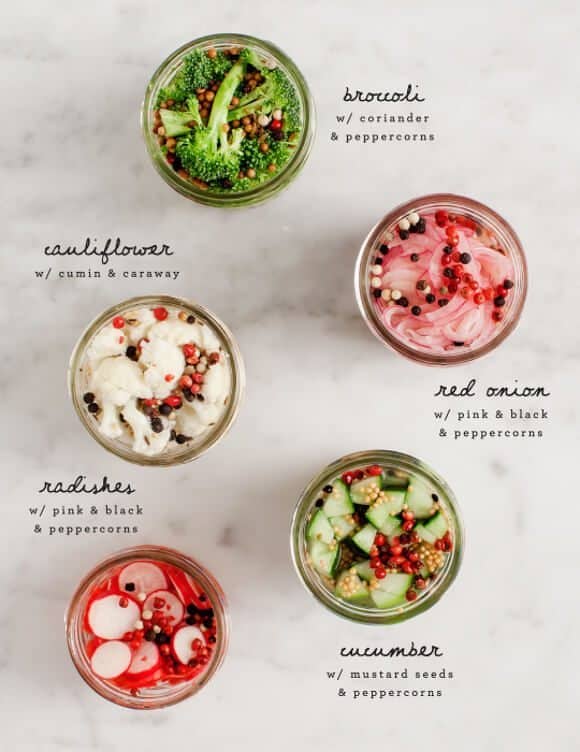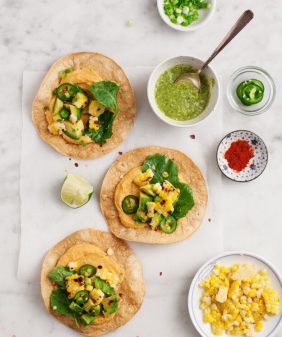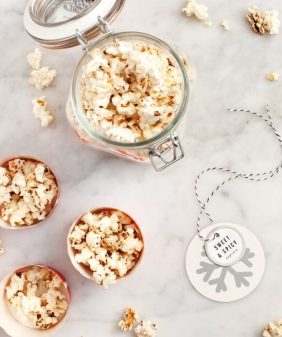A simple pickle recipe that's great for pickling broccoli, cauliflower, radishes, onions, cucumbers, and more!

I love cookbooks and I hoard them pretty obsessively. Although, I’ll admit, I have a hard time following recipes from start to finish. Which is why I love the premise of Kate Payne’s new book, The Hip Girls Guide to the Kitchen. It’s a “hit the ground running approach, seeing as you need to eat three times daily whether you’ve mastered your kitchen or not.”
It’s full of, really, everything you need to know to be pretty successful in your kitchen – from how to set up your pantry to how to put meals together intuitively and economically. (Also she’s gluten free, so she includes tons of dietary options). She offers suggestions for what to buy in bulk, (and what not to), tips for buying kitchen tools from second hand stores, plus tons of clever “hip tricks” along the way. (For example: did you know you can buy a refurbished Vitamix blender for a fraction of the cost? …me neither).

She’s truly your friend in the kitchen and her writing is charming, witty, and just fun to read. Some of my favorite sections are:
Equip your Ship: Setting up your kitchen without winning the lottery
Methodology & Madd Skills: Learning how to cook without books or your laptop
Kitchen Kick-Ass: Tapping into your inner depression-era granny
Using Stuff Up: Preserving projects any beginner can handle

Since I’m clearly a beginner at preserving projects, I instantly gravitated to her recipe for Any Vegetable Vinegar Pickles. Any recipe that has “any vegetable” in the title, is my kind of recipe. I chose cauliflower, broccoli, red onions, radishes, and cucumbers along with a few various spices. Her brine recipe was quick and easy to make. The hardest part is the waiting – she suggest stashing them in the back of your fridge and not touching them for at least a week, although she says 2-3 is the best. (We’ll see if I can hold out that long!)

Click here to go buy her book!
Also, be sure to check out Kate’s blog, as well as these fine fellow bloggers who have also written posts about the book: Food in Jars, Healthy Green Kitchen, Local Kitchen Blog, Autumn Makes and Does, Punk Domestics, Spinach Tiger, and Local Savour.
the giveaway is now closed, a winner has been notified
any vegetable vinegar pickles
- any vegetables you like (I used cucumbers, broccoli, cauliflower, onions and radishes)
- fresh or dried spices (I used peppercorns, cumin, coriander, mustard seeds, & caraway)
- 1 cup any kind of vinegar (I used white wine vinegar)
- 1 cup filtered water
- 1 tablespoon kosher or any non-iodized salt
- optional: 1 teaspoon sugar
- Wash and cut up your vegetables and pack them into a clean jar.
- Add between ¼ - ½ teaspoon of whole dried spices.
- Combine vinegar, filtered water and salt in a medium saucepan and bring to a boil.
- Put your just boiled brine over the vegetables in the jar.
- Wipe any vinegar spills from the rim with a clean towel and put on the lid.
- Hide the jar in the back of the friedge for at least a week. Two weeks is better, three is best.
- Keep them in the fridge for up to 6 months.
I used these Ball jars (and also the smaller version).
recipe published with permission from Harper Collins.















Super simple recipe. What can I do with the brine once the pickle is over?
I top up with a little more salt and vinegar, peppercorns and garlic, other ingredients to taste, and use it again.
These are amazing!! So fresh and tasty, and so simple. Took 10 minutes to put together, if that. Some of the best pickles I’ve had.
This is absolutely my favorite pickling recipe! I’ve now pickled cucumbers, string beans, jalapeños and onions and I’m having so much fun with this delicious way to preserve my harvest!
So I put the jar in the fridge right after pouring the water in? It does not need to sit in the counter for a few days?
yep, these are refrigerator pickles, no need to let them sit on the counter, although you could let the hot jars cool to room temp first (20 mins or so). Hope that helps!
Thanks!!
This is such a great universal recipe for pickling! I’m going to use this with almost every single vegetable I make now! Need to write this one down and share with my kids when they get older! Thank you so much for sharing.
I’m sure everyone does this but I’m short on time so I peel onions or chop lots of my vegetables the day before I can. Then the next day I line every thing on the counter and proceed set up my canners. As everything heats up I pack my sterilized jars. Now I have a question can I do a water bath on these and put them on the shelf until I’m ready to use?
Hi! I’ve just discovered this recipe and would love to try it with red onions, cauliflower and maybe ginger. How full can you fill the jars? How much space should you leave at the top? Also can I substitute an alternative sweetener like coconut sugar, maple syrup or honey? Thanks for the recipe!
I just tried this recipe three weeks ago and today is the day! I am a little nervous because i saw a little fluffy whiteness on one of my cucumbers in the jar last night – is there anything in that recipe book that talks about what to do if you see stuff like that? Most of the googling I’ve done has led me to articles about big-batch salt fermented pickles, not little fridge pickles – I just want to be sure it’s safe! 🙂
I also just tagged my pictures (from when i first poured the brine) on instagram with your hashtag – you can see them if you scroll down a little bit to “3w” ago! 🙂
hmm, I probably wouldn’t eat fluffy whiteness – were your cucumbers fully submerged in the brine? (I should have made that part more clear!)
They were mostly, but one of them escaped a little at the top – i’m not sure how to keep them all down… I’m going to toss that little guy and see how the rest of the jar smells/looks when i open it.
also did you sterilize your jars beforehand? I was a little over-excited and just grabbed my ball jar out of the cabinet and used it. Hopefully that wasn’t my fatal flaw!
How did yours turn out when you did them?
No, I just used a clean jar (sterilizing them is more for canning/preserving – not necessary for fridge). I should have mentioned that I kind of shake my jar a little every few days or so, just to make sure everything’s covered. Usually everything sinks down over time as they soak up more of the brine – the radishes should have been the easiest, let me know how those worked out!
False alarm! What I thought was fuzz was just a really thin slice of cucumber that had was kind of white/translucent. Whew! They all tasted awesome – I did cukes, radishes and green beans, and a jar of each with some red pepper flakes for heat (which turned out great). Thanks for sharing the recipe! I tagged your hashtag in my before/after curing pics 🙂
Phew! So glad you liked them – I saw your pics – awesome :). Glad the 3 weeks was worth it!
Great recipe, and I’m having a blast reading the comments and picking up all of these great kitchen tips! 🙂
Could you can this so it would last a long time. I have so much left over in my garden this would be a great way to use a lot of it up.
Hi Ann, this recipe is specifically for fridge pickles, I’m not sure if the acid level, etc, is safe for canning (I’m not an expert at canning, you might want to check out a site like Food in Jars for better info: http://foodinjars.com/canning-101-archive/)
These look amazing! Just an FYI for readers who have to be aware of nut allergies, pink peppercorns aren’t actually pepper, but dry roasted berries of a plant that is in the same family as cashews and pistachios. There HAVE been reactions reported to these pink peppercorns, so it’s important to be aware!
Can’t wait to explore more of your posts!
great to know, thanks!
Beautiful photos! I love the lighting and styling! Thanks for sharing!
My comment is on the pickle recipe is yum – so easy!! Who knew? Thanks for a chance to win.
Thanks for the recipe. I definitely will use this. i would love to win a copy of the book. Thanks for the opportunity!
My best kitchen tip is anchovies, garlic and walnuts. Heat up garlic and anchovies in oil, add walnuts and sautee with thinly sliced radishes, broccolini, leafy greens or even cooked pasta.
Can’t wait for the bounty of summer to try these pickles!
I keep hearing about great discounts on reconditioned Vitamix, but their website deals are hardly a fraction of the price. Where does one snag such a deal?
My first step in making potato salad is to douse the hot cut up spuds with pickle juice, and then proceed later, when they are cooler, to add the other ingredients in the salad.
I just got this post in my email today. I realize the give away might be over, but my hint is when you use a tablespoon or two or part of a can of something such as coconut milk, tomato paste or condensed milk use ice cube trays to freeze the leftovers and then keep the cubes in zipper plastic bags.
If you are cooking something that can easily be doubled, do it and freeze the extra. SO handy for those evenings that you don’t have time/too lazy to cook!